The snickering of a few guys in their twenties, breaks my reverie and forces me to cast a look around.Quite agitated at this interruption I look beside me to see the trio mischievously discussing a beautifully intricate erotic panel on the adhisthaan or the base of the Lakshamana temple.Here I was at the bashful display of erotica at the most unlikely of the places on earth , the Hindu temples,where guides and escorts unapologetically delved more on the explicit details of human anatomy than on Gods and religious significances of the temples,after all, that is what majority of the people visiting these temples for the first time seek.A sight of the celebration of sexual poses blatantly displayed before the world, rightfully earning them the space in the UNESCO World heritage list.
The last week of February in a perfect time to visit these exquisite masterpieces of sculptures, in the Temples of Khajuraho, in Madhya Pradesh. The time ensures the best of both, a lovely climate to explore the historic site along with the vibrant spread of the Khajuraho Dance festival, giving one more time outdoors to rejoice in the fast passing winters of this exotic location. Khajuraho, is said to be the religious capital of the Chandella dynasty who had their Political capital at Mahoba about 60 kms from here. All the temples in Khajuraho are said to be built by the kings of the Chandella dynasty during the era stretching from 9th to 11th century AD, with the earliest dating 954 AD. Post the fall of the Chandellas , Muslim invaders with their intolerance towards religious places brought about significant destruction of the temples, they seem to have not spared a single sculpture from disfigurement by breaking away all the noses and hands of these magnificient witnesses of bygone times.The Khajuraho temples only 25 remaining of the 125 built,were discovered by British engineer T.Burt in the 18th century,and now stand as breathless examples to the exquisite and perilous workmanship of the sculptors of these aesthetically enriched eras.
I pretty much landed in Khajuraho, with not much on mind about the erotic sculptures , not surprisingly, since with the rapid penetration and easy access of technology, brazen visuals on the internet and television, seems to have satiated most of the inquisitiveness this generation would have towards erotica,in the cities or in the villages likewise. But the visit to the architectural extravaganza was due since a decade now, so I simply felt grateful to have nailed it in rather abrupt travel plan this time around.Having already been to Sanchi and Bhimbetka,it felt apt to have continued this trip to another genre of celebrated Stone monuments, this trip was turning out to be one lovely saga in stones.
After a long bus ride and a quick check in,I went to the main Bazaar street that goes around to flank the Western group of Monuments, the biggest and the most important group of temples n Khajuraho.Besides the Western there are the Southern Group and the Eastern Group of temples for one to cover. Being an archaeological site, the amount of time required to cover Khajuraho might be at the discretion and fancies depending upon the kind of traveller you are and what delights you most. One may choose to cover the entire bunch of monuments in a day,grabbing a rickshaw, point and shoot and be on the way.But ideally it would be rewarding to settle in the place for 3-4 days, let the place grow on you and within you, grab a bicycle and just let the time roll slowly along.I could spare 2 days, which was not so bad but not as adequate for my inquisitiveness.
I start with my study of the Western group, which houses 3 main temples,Lakshamana temple, Kandariya Mahadeva temple and Devi Jagadamba temple along with a few smaller ones like,Chitragupta Temple, Viswanatha Temple, Devi mandapa and the Varaha Mandapa.It is highly advisable to borrow the audio records , which are available at the entrance of the temple complex for a 110/-, as these are very helpful in going around the complex at your own pace, pausing at places required, losing yourself intermittently in the obsolete beauty of the sculptures.One can easily take 6 hrs to complete the western group, if one wishes to note the intricacies of the carvings, rejoice at the small discoveries woven among the stone depictions and photograph at leisure the architectural wonder that took two decades to complete.
With one of these audio compasses strapped on my ears I start my journey to the discovery of amazying sculptures.The First Stop is at the Varaha mandapa, which stands directly opposite to the huge Lakshamana temple.The Varaha is an imposing statue of the Boar which is regarded as the incarnation of Lord Vishnu. The statue carved out of a single sandstone,has been polished like a brass monument and has 108 small figurines depicted over its body. The 1.7 m high monolith stands on four legs on a pedestal having remains of female feet of Goddess Earth. The body of the Boar depicts the Gods rejoicing the journey of the Earth back from the waters, after being saved by Lord Vishnu in this form.Goddess Saraswati adorns the snout of the Varaha.Though quite small this mandapa with it pyramidal roof and complete with the kalasha forms a unique feature of the Western group of monuments.
From here I move on to the Lakshaman temple which houses the diety of Lord Vishnu, and is one of the largest and oldest temple in the group dated AD 954.All the temples in the group face the East,and if one visits the monuments in the mornings, one can witness the early sunrays entering inside the sanctum right into the garbagriha at the feet of the idol as was planned to be. The sheer beauty of that moment is only experienced in the solitude of the mornings at Khajuraho, not to be missed. Right before the Lakshamana temple is the statue of a Mythical Lion ,an emblem of the Chandella dynasty , fighting a warrior at its feet.
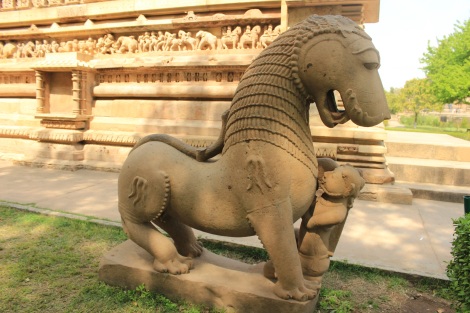
The Mighty fighting Lion , an emblem of the Chandella Dynasty at the entrance of the Lakshamana temple
Typically all the temples at Khajuraho are built in the Northern style of temple architecture, with their mounting shikharas of Nadara architecture much different from their Souther counterparts depicting the Dravidian Vamana Style of Architecture. Due to the scale and spread of the temples, its easy to lose track of details or to cut short and move on.I take a quick round of the entire Adhisthana( base of the temple) before I start the Audio compass.As I move along the base , I see the unfurling of a long scroll, depicting warriors on way to the battlefield, hunting scenes, elephants in fluid motions, horses reined in by their warriors, court scenes, all beautifully carved into a ribbon panel of 10″ high.I cannot not help but marvel at the stories unfolding along my eyes as I move along this ribbon around the entire base of the Lakshamana temple.

The elaborate carvings on the Adhisthana ranging from Court scenes, War scenes to Extreme Erotic Scenes
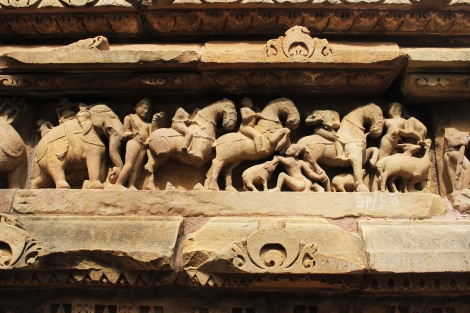
Elaborate Hunting scenes with passionately detailed animals all in fluid movement , more surreal than paintings
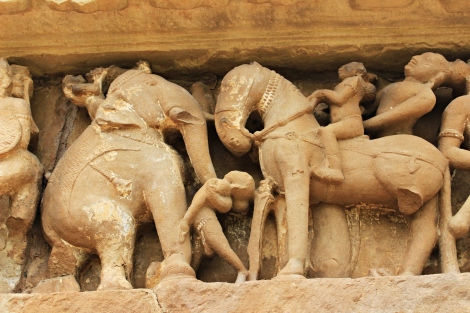
One of my favourite panels , showing a warrior caught in the grip of the Elephant, the stance of the warrior with the fallen sword and the exquisite motifs of his robe.
This path also introduces one to the much acclaimed Erotic sculptures of Khajuraho, which form the very first panel on the Adhisthana. Extreme erotica is depicted with much panache in this panel , with oral sex apparently being the main thought throughout the frame. The next panel also depicts group sexual erotica, and despite it all one cant help but marvel at the details carved into this 9″ human figurines.As I move slowly around the base of the Lakshamana temple,I discover more and get more mesmerized by the details in the stone depictions. Some erotic, some mischievous, some humorous and some stoic and grand, the base contains all sorts of elements woven in tremendous detail within this scroll.
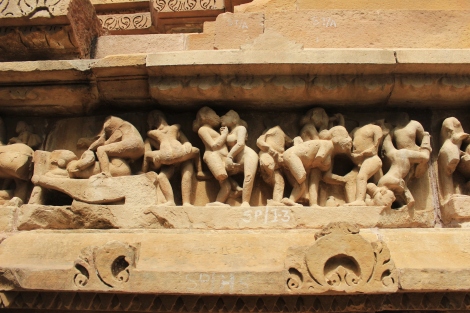
The celebration continued on the second panel along the route, with surprising details packed in the 10″ scroll.

Naughtiness stares at you from this panel , showing the shying away of one of the figures, as the others engage in exploiting the animal.
One feels the joy at identifying and discovering panels and figurines which make one stop in amazement and smile at the master craftsmanship of the sculptor. Lakshamana temple is the only one depicting scores of elephant figures uprooting human heads in war depictions, there are also many horses and few camels all playing their part in the war scenes.This elaborately carved base which has withstood the centuries is the main factor differentiating the Lakshamana temple from the others. The other factor is the presence of exclusive shrines on all the four corners over this base around the temple jaggati.As one climbs up the platform to go around the temple, one can see the exterior walls of the temple are divided into multiple bands with series of small motifs adorning the sectional divides.A row of 1′ high elephant replicas line the base of the Lakshamana temple, another aspect that puts it apart from the rest. A Beautiful Statue of dancing Ganesha adorns one of the walls,this is one of the 9 male deities that seem to be depicted around the temple walls.
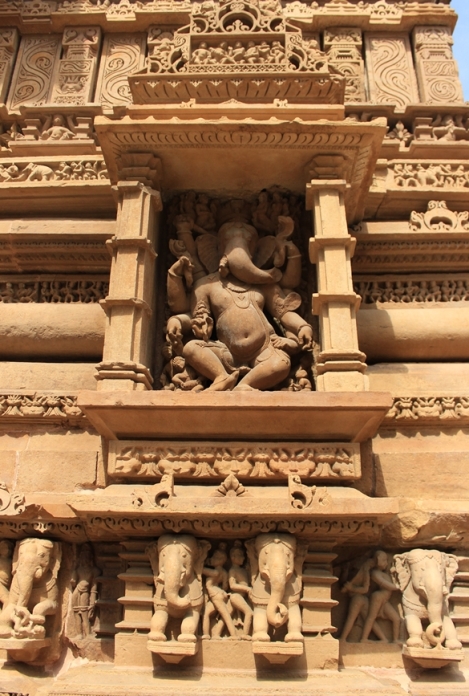
Dancing Ganesha, one of hte 9 male dieties on the Lakshamana temple, along with the elephant frontal replicas.
As I go around the temples I realised there are lot of common aspects to the temple architecture at Khajuraho. I broadly found myself classifying the stone sculptures adorning the main walls of the temples into the following groups-
Makharas-Small monster faced replicas, which are put across the temple to ward off evil
Sur Sundaris -Celestial nymphs well endowed, with curvaceous bodies and tremendous grace, adorn the Main walls of the temples, in various poses of everyday rituals. Exquisitely carved to perfection, for their voluptuous curves,sensuous bellies with cute naval buttons, stretched bodies,adorned with delicately carved ornaments , combed hair and pretty faces.One finds them in various nubile positions,engrossed in their make up, removing thorns from their feet, drying their wet hair, stretching their torso so beautifully, their fine robes with lovely embroideries,surreal transparency of their robes , slipping at times, all worth stopping in your path and absorbing the reality of the era etched in these stones.
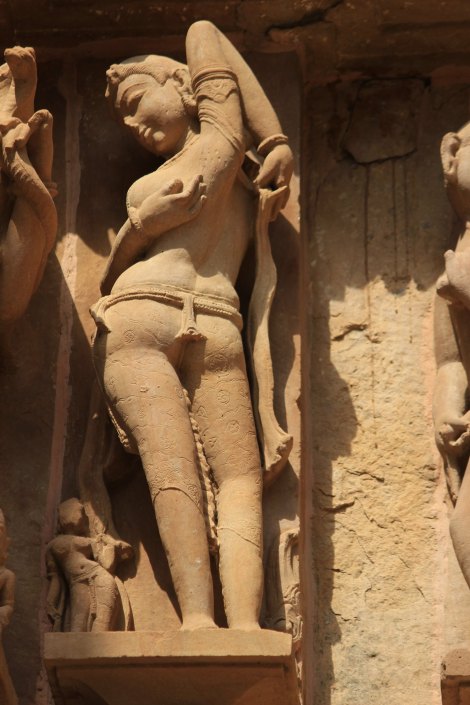
A graceful statue of a Sur suundari, undressing herself, her embroidered finery and lithe figure beautifully sculpted to perfection
Mythical Creatures- Called as the Mythical Vyalas, these are seen as erect statues standing on 2 feet comprising of a lion body fused with a head of different animals. These generally are depicted in between the crevices of the temple walls, often fighting the humans. These are claimed to be a synonym the human negatives like greed , anger etc and Humans are often shown engrossed into fights to win over these attributes of their nature.

The Vyalas located between the celebrated figurines, hidden almost into the crevices & corners of the walls.
Vital Surrounding Figures – Human like statues often seen flanking the Mithunas , mainly positioned at the eight corners of the temple, they often are seen in a tribhanga pose, carrying weapons in their hands as per the scriptures and have a vahana at their feet.
Mithunas -Well endowed couples in various poses of romance and sex adorn the external walls of the sanctum around the circum-ambulatory path of the temple. The erotic sculptures in various positions are also said to signify the culmination of the mental and physical state of the devotees in the supreme act of sex. It also signifies the divine connection experienced by the tantric sex act, which is claimed to be more of a yogic feat than an erotic feat.
Floral Decoratives- Intricate designs are carved on the ceilings of the temples and the sanctum walls, by adopting variations of the floral motiffs.The Lotus form has been depicted in various measures and geometries basis the location of the carvings, in linear array, in circular array, in column corner embellishments, in ceiling patterns etc.
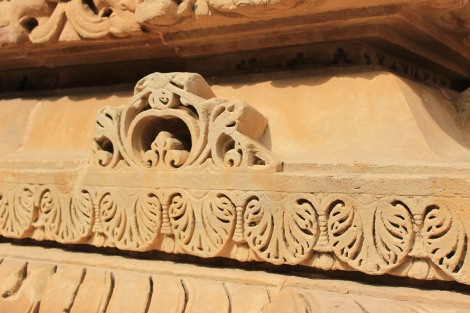
Variations of the floral motifs used in repetition across the perimeter of the temples to format ornate edges and sectional divides
These categories infused with the sculptures of the dieties , together form the order of the carvings on the exterior of any of the Khajuraho temples.
Apart from the above, the entrance of the temples, are decorated with garlands carved from single stone blocks seemed to held across the entry of the temple by the mythical crocodile called Magara. The entry to the AnteMandapa is decorated in form of stone rangoli depicting the half moon and the shells , reminding devotees to cut themselves out of all their earthly cravings before entering the sanctum. The Lakshamana temple sanctum has a beautiful statue of Vishnu,in a very pristine state.I go aorund the walls of the inner sanctum around the pradakshinapath as I marvel the carvings on the main walls of the sanctum.As I go around the path, I can see the difference in the color of the stone used within the temples, the difference in the carvings and the motifs are very striking but no less exquisite. Contradictory to the fact stated that no sexual positions are depicted within the temples, I do end up finding some tiny 4″ figurines in such poses on the sanctum walls in Lakshamana temple.
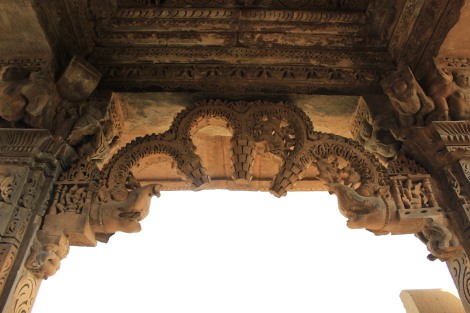
Closer view of the stone garland caarved from a single block of stone and stretching across from the mouths of the Magaras, with little celestial winged angels signifying connection to heaven

The exteriors of the inner Sanctum as seen from the Pradakshina path, the black stone gleaming beautifully in the filtered sunlight
The roof of the temple Mandapa is equally exquisite in terms of extensively carved ceilings. There are a group of 16 pillars within the temple antechamber. Beautiful light filters in from the twin galleries present on either sides of the temple walls, lighting up the mandapa.I gaze on in a trance at the scores of figures of four armed dwarfs holding the brackets of the pillars and facade of the sanctum wall.As I move around appreciating the light coming through the side galleries , I find myself staring into beautifully carved figurines of Sundaries, placed within the groove of the Twin columns.These unlike the exterior ones have more elaborate jewellery, finely carved,and looking more attractive in the black stone.Being in Black stone, these figures end up looking more like charcoal paintings than stone sculptures.
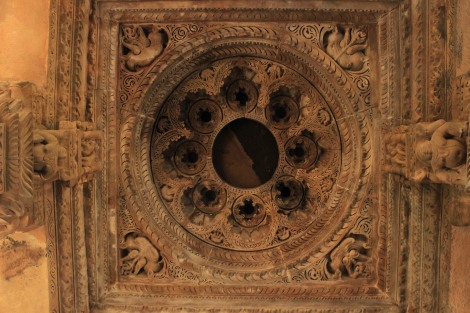
Ornately sculpted stone panels decorating the ceilings of the Mandapa,with makkharas and dwarf figures adorning the corners
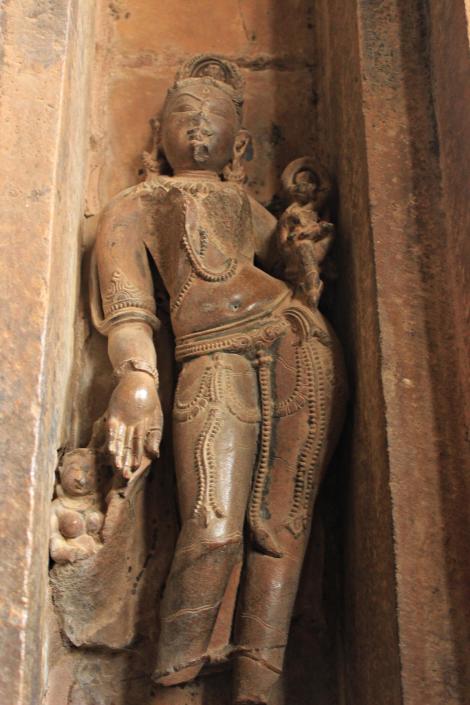
The more intricately sculpted sundaris , their gracefully curved torso,within the Mandapa flanking the Galleries
Next I move west to the Kandariya Mahadeva temple.This temple built in 1040 AD,dedicated to Lord Shiva, is a most beautiful piece of architecture in the entire group of Khajuraho temples.This temple has also been extensively studied with respect to the fractal architecture principles followed in the plan as well as the elevation of the temple.A fractal is a mathematical set that typically displays self similar patterns, which means they are “the same from near as from far”. Fractals may be exactly the same at every scale, or as illustrated they may be nearly the same at different scales.They include the idea of a detailed pattern repeating itself.The Temple attains its pyramidal shape , due to the 84 fractal formation ascending together and culminating into the spire , a synonym of the Everest peak in the Himalayas.
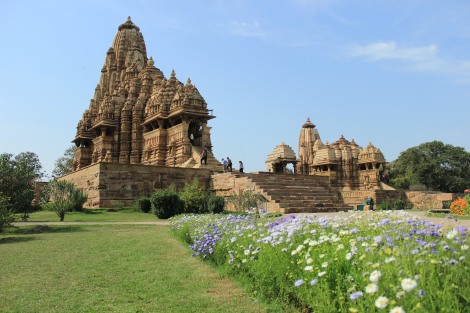
A view on the approach of the Majestic and intriguing geometric perfection symbolized by the Kandariya Mahadeva Temple
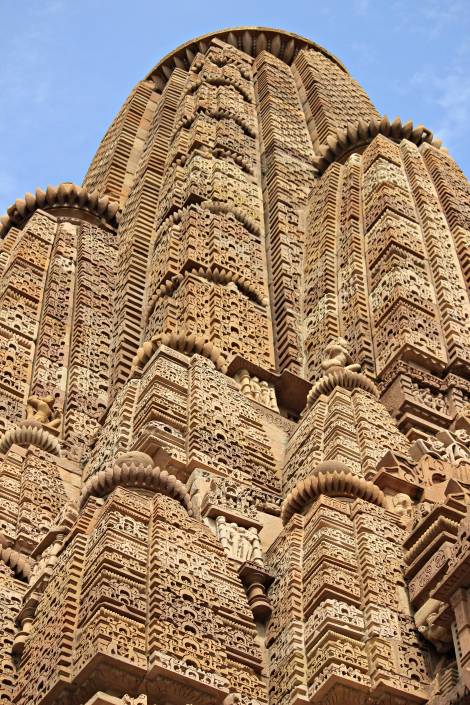
Fractal Geometry in the architecture of the temple, highly celebrated in the design of its Shikhara.
Since Hindu philosophy views the cosmos to be holonomic and self-similar in nature – each fragment of the cosmos is believed to be whole in itself – temples are designed and constructed as models of the cosmos and hence demonstrate this fractal geometry.After Delving on this interesting insight I move closer to the temple to examine the more celebrated sculptures adorning its walls. The adhisthana of the Kandariya Mahadeva temple, seems to have been restructured and does not depict any extravagant carvings as those of the Lakshamana temple. The outer walls of the Pradakshina path, carry 3 rows of a meter high bands of figurines carved over them.I move around guided by my audio compass, halting every 2 steps to appreciate the nuances of the statues.Here across the walls are some of the most celebrated erotic sculptures. Despite their proclaimed fame, these sculptures form less than 10% of the total art affair depicted in Khajuraho together.Even this estimate cited by the audip compass sounds exaggerated to me, as I do not come across too many of such erotic depictions in my quest.I pause to look at the mutilated figure of Goddess Kali at one of the walls.Once again I am spellbound at witnessing the precision and pain taken to carve out such detailed sculptures covering all walls of the temple. The figures follow an order similar to those cited at the Lakshamana temple.This temple carries a more erotic sculpted figures in line with the temple diety , Shiva.Shiva ( linga )and Shakti( Yoni) are symbolized as the Yin and Yang in the Hindu scriptures.
The adhisthana of the Kandariya Mahadeva temple stretches out beyond the temple to accomodate the Devi Jagadamba temple and the small mandapa in between , which carries the statue of the Chandella emblem the Lion is its fighting pose. I quickly go around the rest of the temple complex, which principally run on the same lines.The Devi Jagadamba temple as also the Chitragupta temple dedicated to the Sun God are much smaller in scale and do not have a pradakshina path around the inner sanctum.
As I step down from the Adhishthana,I take some time to laze under the lovely shade of the tree outside the Chitragupta temple admist the beautifully landscaped temple premises.The carpet of dry lies stretching before me forms a beautiful autumn foreground for the Lovely Kandariya Mahadeva temple with the rosy sunset for its backdrop.
Despite giving 6 hours to the western group of monuments, I find myself struggling to finish the Vishvanatha temple dedicated again to Lord Shiva.Parts of the temple seemed to be in restoration with scaffolding spread out across. I walk over the Jaggti to have a view of the Monolith Nandi, placed in a 12 pillared porch facing the Vishvanatha temple.
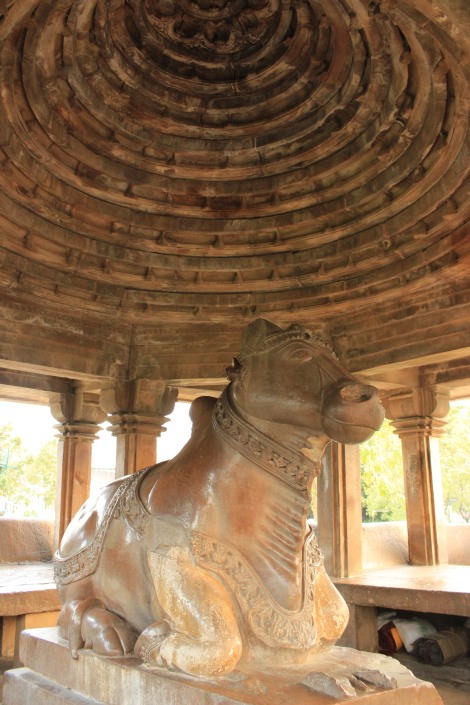
The Simple monolith presence of the Bull, Nandi in the 12 pillared mandapa with its uniquely conical roof.
With my soul immersed in the beauty of these temples and awe settling n my mind for the master sculptors of the era I walk out of the western group of monuments in a dreamy haze of the 11th century.Once out I go straight to the much acclaimed Raja Cafe, right opposite to the monument group. Here from atop the cafe I still gaze out to the shikharas of the Kandariya Mahadeva temple & Vishwanatha temples.
My mind goes back to the erotic sculptures, that exude not pornography but the finest level of imagination and craftsmanship by the sculptor. There are many hypothesis, reasoning the depiction of sex iin the Hindu temples. Khajuraho by no means is the only canvas of such exhibits, I have seen these before at Belur , Haleibid, smaller temples at Banavasi , only here they have received more popularity.Various stories exist around their being, one says they were to test the perseverance of the hermits residing in the temples, next says, they imparted education to the young boys who where required to spent their youth in brahmacharya at the temples , to prepare them for the world post their temple education, yet one says that they provide assistance in the path of Moksha through Kama. TheThe theories are endless and each sounds justifiable or idiotic just the same. All said, the sculptures are historic and indicate the liberated thinking of the era to allow such forms to decorate the walls of their sacred places.
With many such thoughts lingering on my mind I skip on to Raja Cafe across the Western group of monuments.Teaming with lot of foreigners, the cafe, with it lovely hippy soulful aura is a good end to the long day.

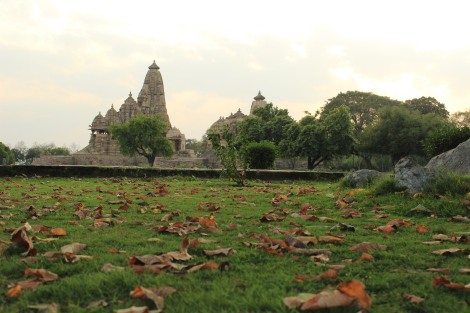

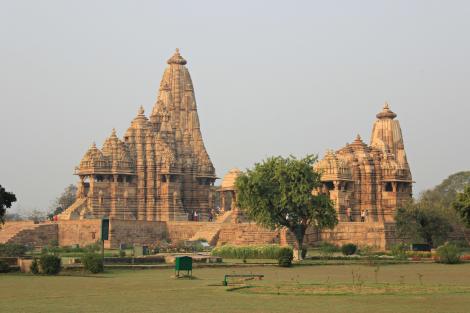
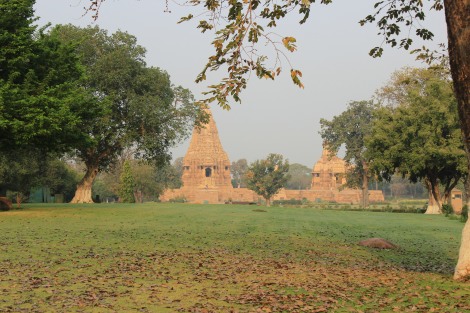
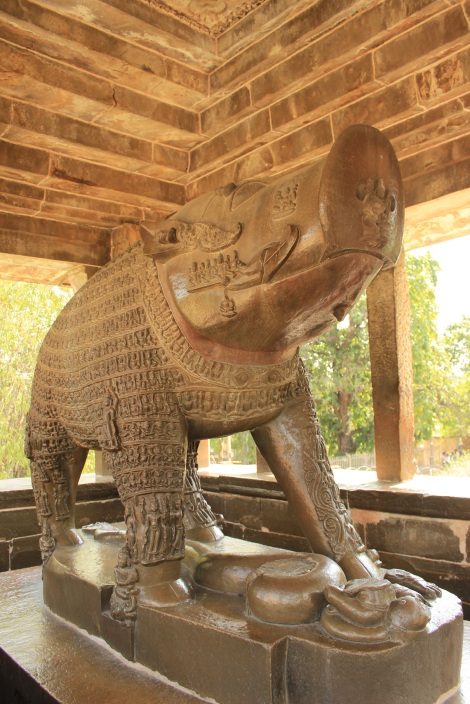


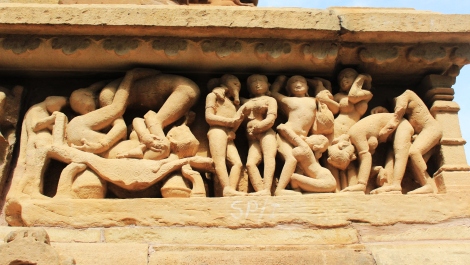

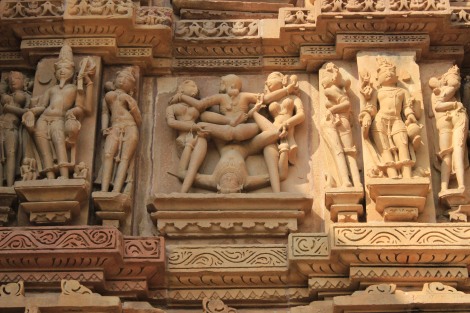
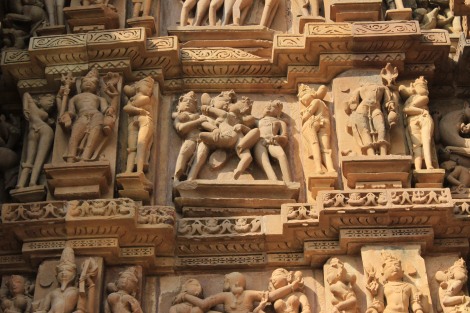
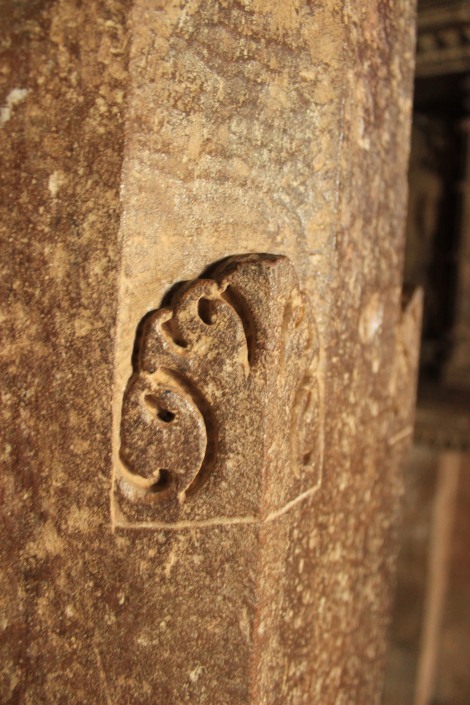



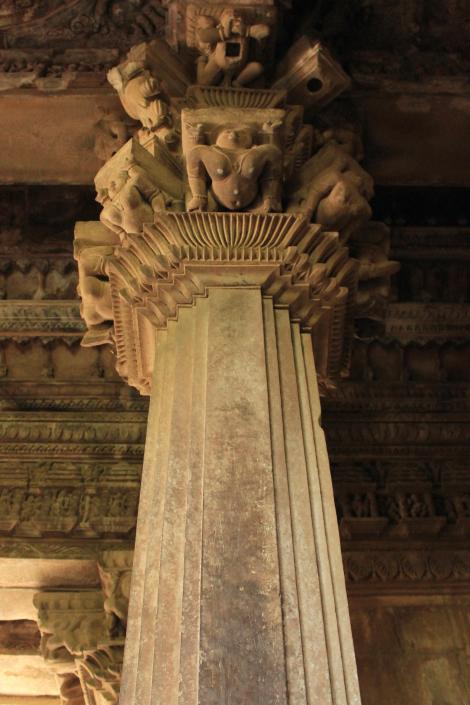


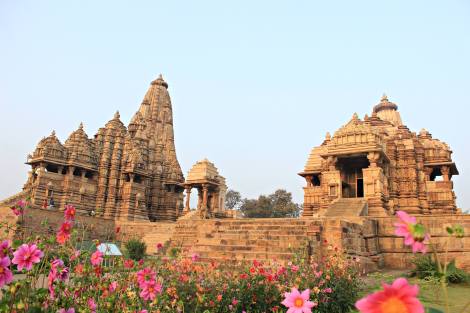
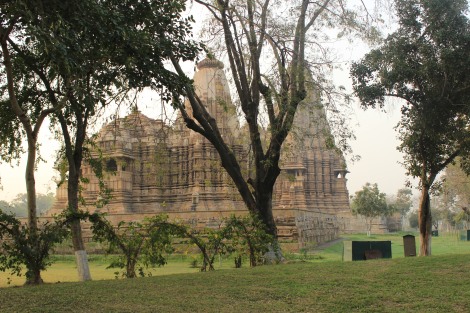
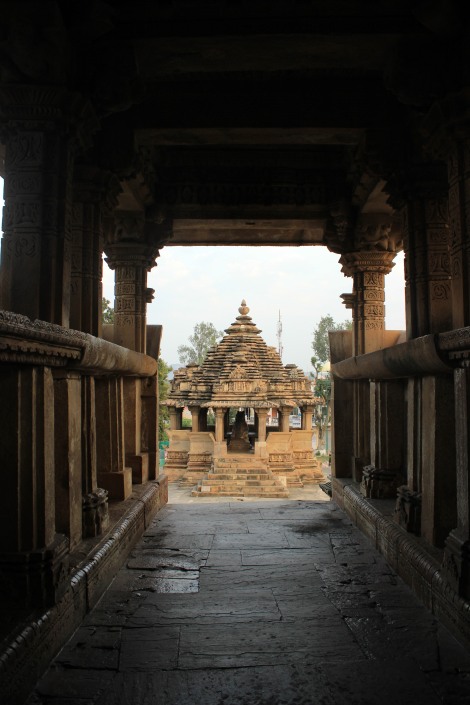


Pingback: Square and Circle of Hindu Temple Architecture – Viewpoints which Matter·
Brilliant work, sir.
LikeLike
Thank you so much Shubham
LikeLike
Reblogged this on Santa's Reindeer and commented:
A beautifully written and detailed post…
LikeLike
Thank you so much for the share
LikeLike
Love the detailed write up, would be returning to it again and again…. Would love to reblog it if permitted 😊
LikeLike
Thanks Santosh. Glad you read through. Ofcourse you can reblog.. thats a pleasure. thanks
LikeLiked by 1 person
it reminded me of one rainy season … I spent a whole day on bicycle to explore that place. that was a single day visit to that awesome place … now I feel that was injustice. Thanks for sharing.
LikeLiked by 1 person
🙂 i spent 2 yet felt its not enough. Will go back post rains. Thanks for your comment
LikeLike
Thanks for your words of appreciation. Being an architect, I am obsessed with describing the same.
LikeLiked by 3 people
A fantastic post . Great shots and your narrative and description is so apt and balanced. Great work !
LikeLiked by 1 person
thank you
LikeLike
🙂 thank you Levy!
LikeLike
Very interesting 🙂 .. I hope you are also Teacher in Architecture. Your interest and passion will help the future generations and importantly a glimpse into the magnanimity of Indian Architecture over western influence. 2 Thumbs up 🙂
LikeLike
Thank you. Though i wish i could take up Architecture history studies myself dude…its fascinating.
LikeLike
Khajuraho…..Interesting description with the excellent clicks….Erotic art, at itz best !!! Good Job Shilpa
LikeLiked by 1 person
Thank you!
LikeLike
Intricacy at it’s best… Esquisite pictures with detailed information… Kudos Girl!!!
LikeLike
Thank you Deepa! 🙂 pretty lengthy
LikeLike
totally amazed at the allaboratewell scripted description.
LikeLiked by 1 person
Thank you Rahul
LikeLike